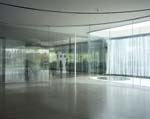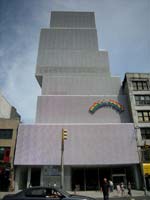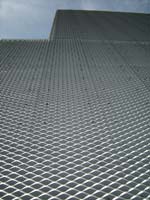
|

|
|
Home Site Search Contact Us Subscribe
|
|
|
Celebratory Meditations on SANAA Winning the Pritzker Prize By Norman Weinstein March 29, 2010 This Pritzker Prize recognizes that ever-elusive transparency, apparently lost in the political sphere, can glowingly articulate an intimately immense place, drifting with cumulus-lightness. Kazuyo Sejima and Ryue Nishizawa design with the window, mirror, cloud, and park as central metaphors. Park? Sejima explained in a recent NPR interview: “a park...In Japan we have a park, which means very open space, and there, different aged people share the space. And sometimes a big group. At the same time, beside them, I can go spend my very quiet time alone.”
In my conversations with the staff of the Glass Pavilion of the Toledo Museum of Art, arguably SANAA’s signature building thus far, they expressed surprise and delight over the unexpected quiet zones the pavilion’s curving glass panels offered. When visitor hubbub wasn’t simply dampened by the pavilion’s glass walls, it seemed playfully re-directed. Thus, the omnipresence of engineered glass in the glass museum became a sound design of a performance hall for audience music. Experience SANAA’s Toledo Glass Pavilion as one elegant materialization of composer John Cage’s “Four minutes, thirty-three seconds” of silence.
********** The Unbearable Lightness of Being?
Nada.
This is the spiritually sensual lightness of being in building, 21st-century Zen aesthetics, brought to you via the double-edged samurai sword of high-tech design tools and materials and alchemized Japanese vernacular art. Thank you, Ando, for opening up the park gate for Sejima and Nishizawa. Thank you, Mr. Wright, for never retreating from glass as talismanic “magic material.” Not New York’s, or Chicago’s, or Dubai’s skyscrapers as a thick center of an architectural starry night, but Ryoanji, Kyoto’s Zen rock and sand garden SANAA seems to draw inspiration from. The full aesthetic overload, the sheer sensual vortices of raked quartz, original silicon chip conductors, circling 15 rocks, those mutable patterns of refractions Westerners label “austere.” In his indispensable The Architecture of Natural Light (Monacelli Press, 2009), architect and educator Henry Plummer offers seven categories, or lenses, through which SANAA’s achievement can be cogently analyzed and savored: evanescence, procession, veils of glass, atomization, canalization, atmospheric silence, and luminescence. No lighter vocabulary in English could be conceived.
**********
Manhattan’s New Museum of Contemporary Art introduced elegant whimsy into museum design, that most monumentally staid of architectural pastimes. The nearly-toppling tower of seven shimmering, shifting gift boxes brings to mind the unique art of Japanese gift-wrapping, then a harried shopper in a Kyoto department store judiciously balancing her slippery tower of perfectly wrapped gift boxes. The art of Japanese gift wrapping is called tsutsumi, the word’s root meaning “to refrain, to be discreet.” Towering 174 feet on an unlikely Bowery block, SANAA’s design might initially seem visually immodest, even brazen in letting passersby peer panoramically through its ground floor – but its aluminum mesh cladding above ground level discreetly reminds unruly strangers that there’s an admission price to be paid, literally and metaphorically, to bask in the pale-pearl, opulent light of its galleries
**********
SANAA’s achievement in light of a poem by George Oppen:
I think there is no light in the world but the world
And I think there is light
Norman Weinstein writes about architecture and design for Architectural Record and The Christian Science Monitor, and is the author of “Words That Build” – an exclusive 21-part series published by ArchNewsNow.com – that focuses on the overlooked foundations of architecture: oral and written communication. He consults with architects and engineers interested in communicating more profitably. You can reach him at nweinste@mindspring.com.
More by Weinstein:
Op-Ed: Life After Ada: Reassessing the Utility of Architectural
Criticism
Book Review: Keeping
the Architectural Profession Professional: "Architecture from the Outside
In: Selected Essays by Robert Gutman" celebrates Gutman's legacy as
invaluable outsider
Twilight Visions: Vintage Surrealist Photography Sheds
New Light on Architecture
Best
Architecture Books of 2009
Book Review: "Gunnar Birkerts: Metaphoric Modernist" by Sven Birkerts and Martin Schwartz A major architect in the history of Modernism finally receives recognition – and sundry asides about why Modernism never exited.
Book Review:
"Urban Design for an Urban Century: Placemaking for People," by Lance
Jay Brown, David Dixon, and Oliver Gillham
Book Review:
"Everything Must Move: 15 Years at Rice School of Architecture
1994-2009"
Book Review: A Subversive Book Every Architect Needs:
"Architect's Essentials of Negotiation" by Ava J. Abramowitz
Book Review: A Perspective from One Elevation: "Conversations With Frank Gehry" by Barbara Isenberg Gehry's conversations offer portraits of an astute listener as well as talker, an architect as aware of his flaws and limitations as of his virtues.
Best Architecture Books of 2008
Book Review: You've Got to Draw the Line Somewhere A review of Drafting Culture: a Social History of Architectural Graphic Standards by George Barnett Johnston
Book Review: "NeoHooDoo: Art for a Forgotten Faith," edited by Franklin Sirmans Sharpen your pencils - and get ready to do a NeoHooDoo shimmy.
|
(click on pictures to enlarge)  Hisao Suzuki, Courtesy of SANAA Glass Pavilion, Toledo Museum of Art, Toledo, Ohio, 2006  Kristen Richards New Museum of Contemporary Art, New York City, 2007  Kristen Richards New Museum façade detail |
© 2010 ArchNewsNow.com